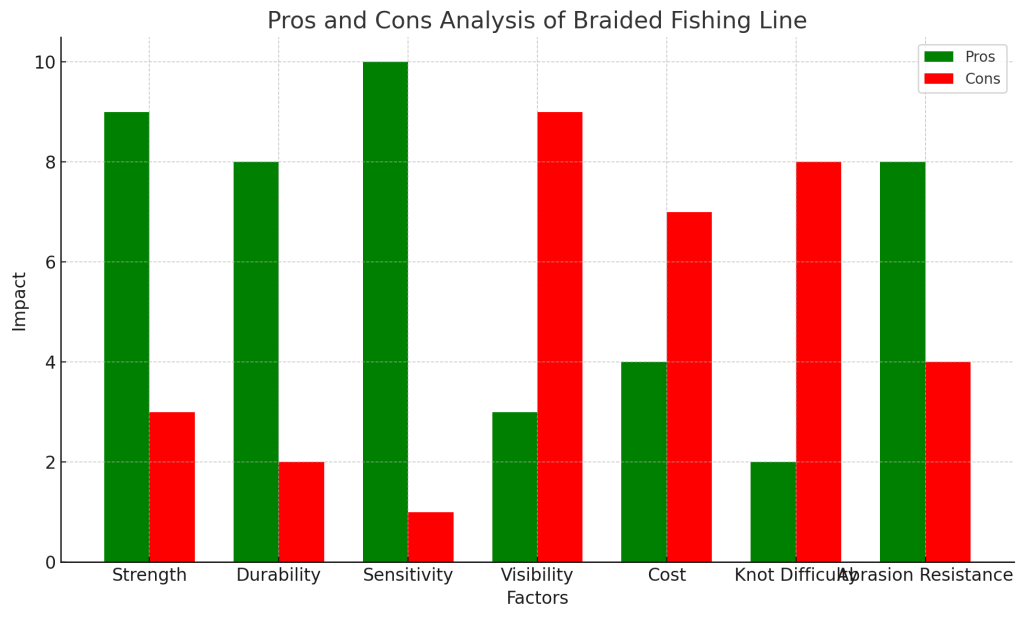Currently Empty: $0.00

Braided fishing lines have been a popular choice among anglers for years. Known for their unique characteristics, they offer both advantages and disadvantages depending on the fishing situation. In this article, we’ll explore the pros and cons of braided fishing line, helping you decide if they are the right choice for your needs. Understanding these factors can significantly enhance your fishing experience.
Pros of Braided Fishing Line
1. Exceptional Strength
One of the most significant advantages of braided fishing lines is their strength. Braided lines are made from multiple strands of strong fibers, which makes them incredibly robust. This strength allows anglers to reel in larger fish without worrying about the line snapping under pressure.
2. High Durability
Braided lines are highly durable, often lasting longer than monofilament and fluorocarbon lines. They are resistant to UV rays, which means they won’t degrade as quickly in sunlight. This durability ensures that you get more use out of your line, reducing the need for frequent replacements and saving money in the long run.
3. Superior Sensitivity
Another key advantage is the sensitivity braided lines provide. With almost no stretch, they allow anglers to feel even the slightest nibble on their bait. This sensitivity can make a significant difference when fishing for species that are known for their delicate bites. The ability to detect subtle movements can lead to more successful catches.
4. Low Visibility in Water (with right color)
When matched with the right color for the water conditions, braided lines can become nearly invisible, making them less detectable to fish. This can be a critical factor in clear water where fish are easily spooked by visible lines. The wide variety of color options available allows you to choose a line that blends seamlessly with the environment.
Cons of Braided Fishing Line
1. High Visibility in Clear Water
While braided lines can be low-visibility with the right color, they can also be highly visible, especially in clear water conditions. This visibility can deter fish from biting, making it harder to catch them. For this reason, many anglers prefer to use braided lines in murky or deep water where visibility is less of a concern.
2. Knot Difficulty
Tying knots with braided lines can be more challenging compared to other types of lines. The slippery texture of braided fibers can make knots more prone to slipping if not tied correctly. This can be a disadvantage for beginners who may struggle to secure their tackle properly. Anglers must learn specific knots that work best with braided lines to avoid this issue.
3. Cost
Braided fishing lines are generally more expensive than monofilament or fluorocarbon lines. The higher cost can be a barrier for some anglers, especially those who fish casually or are on a budget. However, the longer lifespan of braided lines can offset this cost over time, making them a more economical choice in the long run.
4. Abrasion Resistance
While braided lines are strong, they are not as abrasion-resistant as other types of lines. They can wear down quickly when dragged across rough surfaces such as rocks or debris. This can lead to breakage at inopportune times, which is why some anglers opt for more abrasion-resistant options when fishing in rocky areas.
Conclusion

In conclusion, braided fishing lines offer a range of benefits that make them an excellent choice for certain fishing situations. Their strength, durability, and sensitivity are unmatched, making them ideal for targeting large fish and detecting subtle bites. However, they also come with drawbacks such as high visibility in clear water, knot difficulty, and a higher cost.
When choosing whether to use braided fishing lines, consider the specific conditions you’ll be fishing in. For murky waters and big game fishing, the pros may outweigh the cons. On the other hand, in clear waters or when fishing on a budget, you might find the cons more significant. Ultimately, the decision comes down to your personal preferences and fishing needs.


